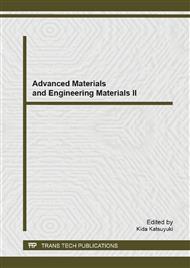[1]
P. M. Dickens, J. L. Sullivan, J. K. Lancaster: Wear, Vol. 112, No. 3-4, (1986), pp.273-289.
Google Scholar
[2]
G. Zhang, H. Liao, H. Li, C. Mateus, J. M. Bordes, C. Coddet: Wear, Vol. 260, No. 6, (2006), pp.594-600.
DOI: 10.1016/j.wear.2005.03.017
Google Scholar
[3]
G. Theiler, T. Gradt: Wear, Vol. 269, No. 3-4, (2010), pp.278-284.
Google Scholar
[4]
Z. P. Lu, and K. Friedrich: On sliding friction and wear of PEEK and its composites, Wear, Volumes 181-183, Part 2, March 1995, Pages 624-631.
DOI: 10.1016/0043-1648(95)90178-7
Google Scholar
[5]
Y. Yamamoto and M. Hashimoto: Wear, Vol. 257, (2004), pp.181-189.
Google Scholar
[6]
I. D. Graham and G. H. West: Wear, Vol. 36, (1976), pp.111-117.
Google Scholar
[7]
B. Vieille, J. Aucher and L. Taleb: Composites Part B, Vol. 242, (2011), pp.341-349.
Google Scholar
[8]
H. Unal, U. Sen and A. Mimaroglu: Materials and Design, Vol. 26, (2005), pp.705-710.
Google Scholar
[9]
D. L. Burris, W. G. Sawyer: Wear, Vol. 261, (2006), pp.410-418.
Google Scholar
[10]
M. Harrass, K. Friedrich, and A. A. Almajid: Tribology International, Vol. 43, (2010), p.635–646.
DOI: 10.1016/j.triboint.2009.10.003
Google Scholar
[11]
A. Wang, R. Lin, C. Stark and J. H. Dumbleton: Wear, Vol. 225, No. 229-2, (1999), pp.724-727.
Google Scholar
[12]
R. T. Wilson, U.S. Patent 5, 568, 983. (1996).
Google Scholar
[13]
G. H. West and J. M. Seniort: Triborogy, Vol. 6, No. 6, (1973), pp.269-275.
Google Scholar
[14]
Y. Yamamoto and T. Takashima: Wear, Vol. 253, (2002), pp.820-826.
Google Scholar
[15]
Z. Hanmin, H. Guoren and Y. Guicheng: Wear, Vol. 116, (1987), pp.59-68.
Google Scholar
[16]
M. H. Cho and S. Bahadur: Wear, Vol. 258, (2005), pp.835-845.
Google Scholar
[17]
K. Friedrich, Z. Zhang and A. K. Schlarb: Composites Science and Technology, Vol. 65, (2005), pp.2329-2343.
Google Scholar
[18]
H. Unal, U. Sen and A. Mimaroglu: Tribology International, Vol. 37, (2004), pp.727-732.
Google Scholar
[19]
K. Mizobe, T. Honda, H. Koike, E. C. Santos, K. Kida and Y. Kashima: Advanced Materials Research Vol. 566 (2012), pp.157-161.
Google Scholar
[20]
K. Mizobe, T. Honda, H. Koike, E. C. Santos, K. Kida and Y. Kashima: Advanced Materials Research Vol. 567 (2012), pp.66-70.
Google Scholar


